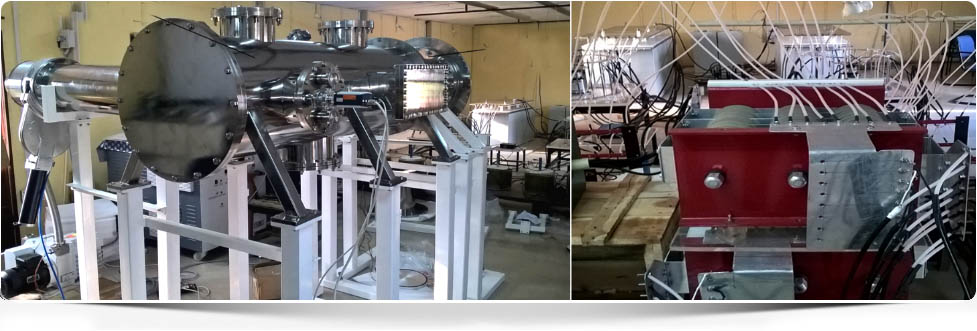
|
||||||
|
||||||
 |
||||||
|
Pulsed Plasma Accelerator Laboratory (PPAL) |
||||||
|
Overview of the laboratory
A pulsed plasma accelerator (PPA) facility has been commissioned at CPPIPR in 2016, which is capable of producing fusion grade plasma stream for a short duration of $0.5 ~ms$
and can deliver $GW/m^2$ level power density to a target. The PPA is powered by a 200 KJ pulsed power system (PPS), which is probably the one of the largest pulsed power
system in the country. The device will provide a platform for studying Plasma Matter Interaction (PMI) relevant to tokamak, and will provide information on sustainability
of structural material such as tungsten and how to avoid degradation / recrystallization of it. Additionally, this will provide important inputs regarding formation of
dust during tokamak operation, which cause disruption of the plasma. 200kJ Pulsed Power System
A 200 kJ pulsed power system (PPS) has been built up at CPP-IPR as a driver for pulsed plasma devices. which delivers a damped sinusoidal current pulse of time period
~1 ms and peak current of 100 kA. This is achieved by using two capacitor bank modules of 100 kJ which individually gives a current pulse of 50 kA. Each of the
modules is formed with 5 numbers of 178μF capacitors connected in parallel (net capacitance 890μF), an ignitron switch (Make: Richardson Electronics, NL8900) and a pulse
shaping unit. The capacitor banks are charged to −15 kV maximum using a negative high voltage DC power supply. The ignitron switch is used to discharge the energy stored
in the bank to the electrodes of the plasma chamber through a pulse shaping inductor and resistor which limits the current and controls the time period of the pulse.
A fiber-optic triggering unit controls both the modules.
Pulsed Plasma Accelerator System (PPA)
The PPA is basically a two coaxial electrode system where one end of the electrode is kept closed and the other end is kept open at a high vacuum condition (10-6 mbar).
The electrical breakdown of the existing gas is made by applying a high voltage (-15kV) pulse from the PPS in between the electrodes. This discharge creates a current
sheath between the electrodes and is accelerated towards the open end by J x B force. When the duration of plasma discharge exceeds the time of flight of the plasma particles
in the accelerating channel in between the electrodes, this is known as a Quasi-Steady Plasma Accelerator (QSPA). This device has the property of a much longer duration of
the plasma stream generation which is suitable to study erosion in materials due to the impact of transient high heat flux plasma stream important in large fusion devices.
The PPA consists of three chambers, viz., the electrode chamber (source chamber) where the plasma is produced, the intermediate chamber where the plasma will be subjected
to the external magnetic field, and the target chamber where material study will be carried out. The electrode chamber has a length of 0.470 m and a diameter of 0.360 m and
houses the coaxial electrodes. The radii of the inner electrode (cathode) and the outer electrode (anode) are 0.025m and 0.085m, respectively.
These electrodes are not continuous but are rather discrete rods, 13 numbers of SS rods in the case of the cathode and 34 numbers of SS rods in the case of the anode.
One end of this chamber is connected to the target chamber and the other end is closed by the electromagnetic gas feeding system. The intermediate chamber can be connected
in between the source chamber and the target chamber when the magnetic field will be applied to the plasma in future. The plasma from the source chamber enters the target
chamber where the plasma is characterized using different diagnostic tools and the plasma stream is exposed upon target samples for material study. The length of the target
chamber is 1.5m, and the diameter is 0.5m. The photograph shows the plasma system comprising the source chamber with the target chamber and the electrode assembly along with
the 200 kJ PPS.
The present PPA has peak discharge current of $100 ~kA$ for a time period of 1 ms. At present the facility is providing ≈ $0.7~GW/m^2$ power without application of external
magnetic field. Presently the facility can generate plasma beam of ≈ $20~Km/s$. The beam density is also $10^{21}/m^3$ which is comparable to the plasma accelerators of
similar magnitude that exist in other parts of the world. The photograph shows an image of the plasma stream generated in PPA, which is captured with a Pinhole Camera.
In future, the plasma beam production will be modified with application of external magnetic field. This will likely to increase the uniform density of plasma beam over
the whole duration of plasma beam. The PPAL group is now engaged further for characterization of the plasma beam. Further work to explore plasma mater interaction under
external magnetic field is also under progress. | ||||||
|
Quick Links |
|||||
| Home | Profile | Gallery | RTI | Webmail | Reach Us |









